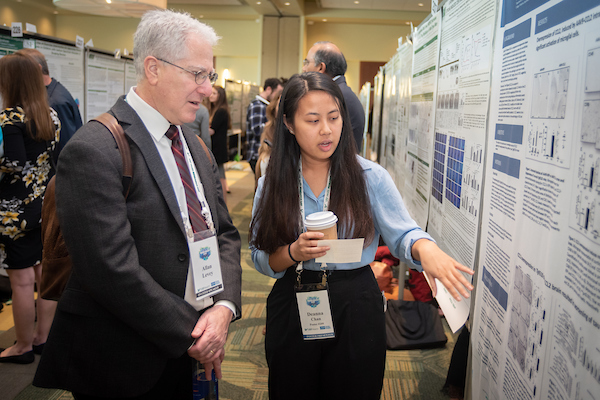
USF Health Research Day 2020 keynote speaker Allan Levey, MD, PhD, spoke about some of his work with national collaborators from various disciplines. He directs Emory University School of Medicine’s Goizueta Alzheimer’s Disease Research Center, one of 32 NIH-funded ADRCs in the U.S.
Alzheimer’s disease, affecting as many as one out of every two people over age 85, is an impending epidemic in the U.S., where the rate of people living into their 80s and beyond continues to rise.
Despite the failure of pharmaceutical trials to yield any treatments to halt or delay the devastating brain degeneration of this complex, chronic disease, Allan Levey, MD, PhD, this year’s Research Day keynote speaker, encouraged the audience of experienced and emerging USF Health scientists to remain optimistic.
“Now more than ever is the time to invest in research. We have powerful new tools and interdisciplinary approaches that are helping us discover more about the root causes of Alzheimer’s disease and related dementias,” said Dr. Levey, professor and chairman of neurology at Emory University School of Medicine and director of Emory’s Alzheimer’s Disease Research Center. “So, there is great reason for hope, but we need to wake up the country about the looming crisis.”
Dr. Levey, a practicing neurologist and widely respected neuroscientist, shared his perspectives on the race to cure Alzheimer’s disease as well some data from his own work at Emory and with national collaborators. He co-leads a National Institutes of Health-funded, multi-institutional Open Drug Discovery Center for Alzheimer’s Disease dedicated to advancing and diversifying the pipeline for innovative therapeutics. He also co-chairs an advisory council of the U.S. Department of Health and Human Services’ National Alzheimer’s Project Act Plan, which ambitiously lists as its top goal to “prevent and effectively treat Alzheimer’s disease and related dementia by 2025.”

Deanna Chan, Department of Molecular Pharmacology and Physiology, discusses her neuroscience research poster with Dr. Levey.
Dr. Levy commended the work of USF Health faculty and trainees at the Byrd Alzheimer’s Center, who are embracing new approaches to better understand the underlying causes of Alzheimer’s disease and related neurodegenerative disorders, and to translate those discoveries into urgently needed, effective treatments.
“If you have a foundation of outstanding clinical care like you have here, that becomes a basis for a number of (regional and national) collaborative research opportunities,” he said. “There are huge opportunities for you to make a difference.”
Some highlights from Dr. Levey’s presentation follow:
- Alzheimer’s disease and related disorders belong to a broad family of overlapping neurodegenerative diseases including Lewy body, vascular, and frontotemporal dementias. Studies of postmortem brains show that it’s “extraordinarily rare” for an individual with Alzheimer’s disease to have only the hallmark features of amyloid plaques and neurofibrillary tau tangles, Dr. Levey said. “Alzheimer’s is almost always accompanied by other co-existing pathologies.” Some brain changes shared with Alzheimer’s include alpha-synuclein pathology (present in Lewy body dementia and Parkinson’s disease) and TDP-43 (also found in frontotemporal dementia and ALS).
- Underlying damage to the brain typically builds for 15-20 years before the first symptoms of cognitive decline, like problems with thinking and memory, appear. That presents a major challenge requiring low-cost, noninvasive biomarkers (substances that indicate the presence of disease) to better understand specifically how Alzheimer’s progresses and to help predict the disease’s onset early and what type of treatments are more likely to work. Dr. Levey works with a company developing a simple eye test to visualize accumulating amyloid protein deposits in the retina. And, currently under review is the first potential blood test to measure very low levels of amyloid in the circulation. “We need to intervene before the (brain) degeneration occurs,” he said. “I’m very confident that we’re going to have dramatic advances in detection and diagnosis capabilities over the next year or two, and that would be a game changer.”
- For nearly 20 years, clinical trials mostly focused on developing Alzheimer’s medications and vaccines to block or destroy amyloid plaque formation – without clear success. “What we’ve learned, slowly and painfully, is that we can remove amyloid from the brains of individuals with mild-to-moderate Alzheimer’s disease without changing the progression of dementia,” he said. Now, armed with new genomic and proteomic technologies, researchers are looking for additional molecular and cellular pathways (implicated in inflammation, membrane trafficking, synaptic trafficking, to name a few), which may identify new treatment targets, beside amyloid and tau.
- Some people with genetic risk factors never get Alzheimer’s disease. So, researchers have begun to amass and analyze large amounts of data on modifiable environmental/lifestyle factors — including diet, physical and mental exercise, and cardiovascular risk factors like cholesterol, high blood pressure, and diabetes. What they learn could help keep the brain healthy and stave off cognitive decline in high-risk individuals as they age. Identifying and treating even a third of the (modifiable) risk factors “could have a huge public health impact,” Dr. Levey said.
- Over 200 proteins have been nominated as potential new treatment targets through the NIH’s Accelerating Medicines Partnership-Alzheimer’s Disease. Levey leads one AMD-AD multi-institutional project focused on discovering and validating novel proteomic targets. The researchers apply the latest systems and network biology approaches to integrate proteomic data from donated postmortem human brains (healthy and at various stages of disease). They’ve identified groups of proteins associated with inflammation, and expressed at higher levels in people as cognitive impairment increases, which appear promising as targets for treating early-stage Alzheimer’s disease.

Dr. Levey with Stephen Liggett, MD, USF Health associate vice president for research and senior vice president for research at the Morsani College of Medicine
Dr. Levey also described a clinical trial he recently completed at Emory to test in patients with mild cognitive impairment the effects of atomoxetine, a selective norepinephrine transport inhibitor FDA approved to treat attention deficit disorder. The study results proved encouraging enough to begin designing a larger multiphase drug trial, he said.
-Photos by Freddie Coleman, USF Health Communications and Marketing
